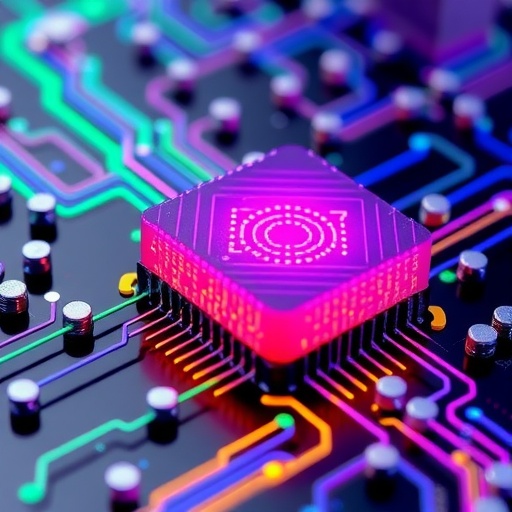The field of computational technology is witnessing a profound juncture, characterized by an escalating disparity between the burgeoning demand for electronic processing capabilities and the stagnating advancements in traditional computing architectures, particularly the von Neumann model. This situation has propelled researchers to explore innovative materials and mechanisms that could potentially bridge this widening gap. Among the most promising candidates are ferroelectric materials, notably hafnium-based ferroelectrics and two-dimensional van der Waals ferroelectrics. These materials exhibit unique partial ferroelectric domain switching behaviors that can mimic the complex temporal dynamics inherent to biological neurons and synapses, suggesting a new frontier in neuromorphic computing.
At the heart of ferroelectric technology lies the ability to manipulate electric fields with remarkable efficiency. Ferroelectric devices leverage changes in polarization that occur when an electric field is applied, enabling a range of functionalities that are not only energy-efficient but also capable of emulating fundamental neurobiological processes. This remarkable feature allows them to operate at a fraction of the energy consumption of traditional memory technologies such as phase change memory (PCM) and resistive random-access memory (RRAM), making ferroelectric materials particularly appealing for applications meant to emulate human cognitive functions.
In our exploration of ferroelectric neuromorphic devices, it is crucial to delve into their underlying principle of operation. Ferroelectric synaptic devices, for instance, can adjust their conductive pathways through electric field-driven polarization mechanisms, which are analogous to the way synapses strengthen or weaken in the human brain based on activity and experience. This dynamic adaptability does not just enhance the capability for data storage; it opens doors to a highly efficient processing paradigm that could lead the charge in next-generation computing systems.
The advancements in device structures and configurations of these ferroelectric materials are noteworthy. Recent developments have shown that various architectures can be employed to optimize performance, such that arrays of ferroelectric devices can be organized into efficient synapse and neuron formations. This arrayed architecture not only supports the parallel processing model that is essential for mimicking brain functions but also allows for higher-density memory solutions, a critical factor as we continue to confront the sheer volume of data generated daily.
Moreover, the promise of physical domain computing—wherein information is processed in its physical form rather than being abstracted into digital signals—holds tantalizing potential for the integration of ferroelectric materials in future systems. This concept leverages the innate properties of materials to perform calculations and process data, fundamentally transforming how we conceive of computational architectures. The prospect of high-density three-dimensional (3D) integration further amplifies the potential of such systems, providing innovative ways to overcome the limitations imposed by traditional planar designs.
Today, it is abundantly clear that ferroelectric materials are not a mere alternative to existing technologies but rather a pivotal element that could define the future of memory systems in computing. Their inherent capabilities to efficiently manage limited writing energy and improve performance metrics could lead to breakthroughs that will allow industries to harness computing power unattainable through conventional complementary metal-oxide semiconductor (CMOS) technologies.
With the trajectory of artificial intelligence and machine learning continuing on its rapid ascent, the efficient processing of massive data sets is becoming increasingly paramount. By utilizing ferroelectric materials in developing neuromorphic memory devices, we could approach AI processing capabilities that resemble human thought processes more closely. The inherent advantages of energy efficiency, size scalability, and processing speed offered by ferroelectric memory devices create a compelling argument for their adoption.
As we reflect on the implications of these developments, the synergy between innovative materials science and neuro-inspired computing is growing ever more critical. The integration of ferroelectric devices into computing systems could elucidate new avenues of research and applications ranging from advanced robotics to sophisticated bioinformatics, paving the way for analytical systems that can learn, adapt, and evolve in ways previously thought impossible for silicon-based technology.
The exploration of ferroelectric materials in the context of neuromorphic computing signals not just a technological shift but also an intellectual evolution within the realm of electrical engineering and computer science. As researchers continue to push the boundaries of what is feasible with these materials, the foundation for future advancements is being laid.
In summary, the intersection of ferroelectric materials and neuromorphic computing represents a promising frontier in overcoming the challenges posed by the limitations of traditional architectures. As the computing landscape transforms, these innovative materials hold the potential to redefine performance benchmarks while drawing closer to the nuances of biological intelligence. This convergence of technology and biology could ultimately lead to machines that operate more naturally and efficiently within environments that increasingly require intelligent processing capabilities.
The ongoing research and practical applications of ferroelectric-based neuromorphic memory devices carry profound implications for our future. As we stand on the brink of potentially groundbreaking advancements in computing, it becomes clear that embracing these novel materials could yield unprecedented efficiencies and capabilities that will shape the forthcoming digital age.
Subject of Research:
Ferroelectric materials in neuromorphic computing.
Article Title:
Ferroelectric-based neuromorphic memory devices for bio-inspired computing.
Article References:
Liu, Y., Tang, W., Zeng, J. et al. Ferroelectric-based neuromorphic memory devices for bio-inspired computing. Nat Rev Electr Eng 2, 773–787 (2025). https://doi.org/10.1038/s44287-025-00222-1
Image Credits:
AI Generated.
DOI:
https://doi.org/10.1038/s44287-025-00222-1
Keywords:
Ferroelectric materials, Neuromorphic computing, Memory devices, Energy efficiency, Biological mimicry, Cognitive computing, Electrical engineering, Scalable architectures, 3D integration.
Tags: bio-inspired computing technologiescognitive computing emulationcomputational technology evolutionelectric field manipulation in materialsenergy-efficient memory solutionsferroelectric neuromorphic memoryhafnium-based ferroelectricsinnovative materials for computingneuromorphic computing advancementspartial ferroelectric domain switchingtraditional computing architecture limitationsvan der Waals ferroelectrics





